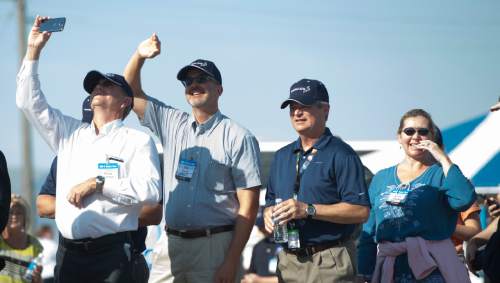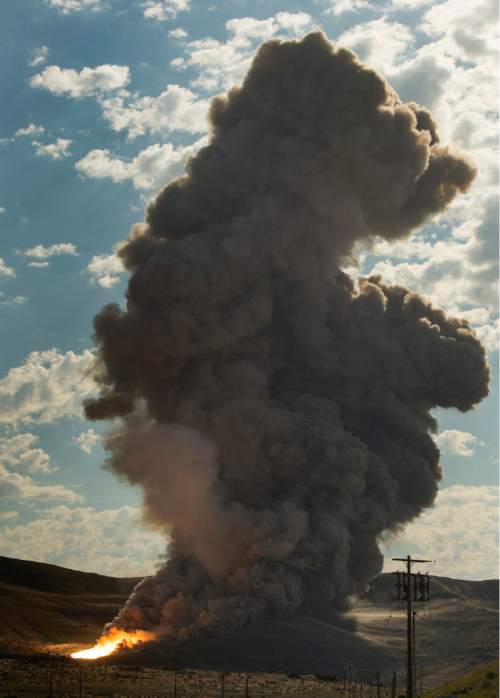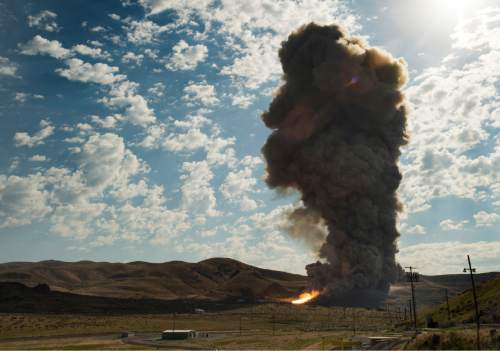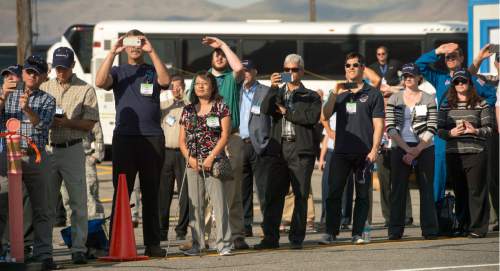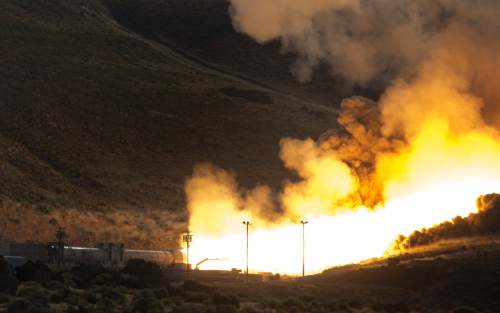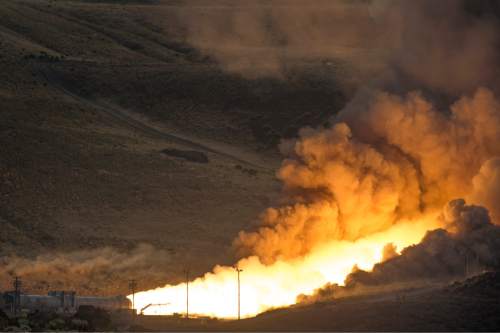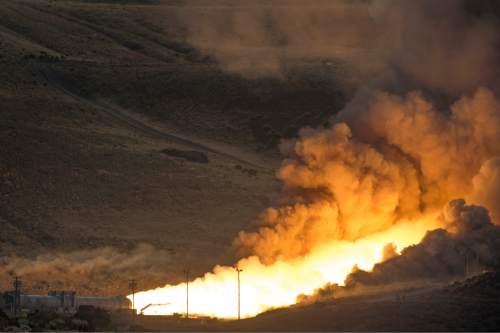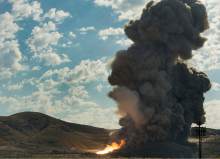This is an archived article that was published on sltrib.com in 2016, and information in the article may be outdated. It is provided only for personal research purposes and may not be reprinted.
Promontory • With the help of Utah industry, humankind took a major leap forward Tuesday in its quest to explore deep space and one day colonize Mars.
NASA and its Promontory-based aerospace contractor Orbital ATK fired a 1.6 million-pound rocket booster in a spectacular blast, the second and final qualification test for the largest and most powerful generation of motor technology ever built.
"This is a huge milestone," said Brian Duffy, a former NASA astronaut who flew four space shuttle missions and was among hundreds of scientists, engineers and space buffs on hand to watch the booster firing.
Tuesday's QM-2 static test, conducted in Utah's west desert shortly after 9:05 a.m., unleashed a hellish, two-minute blaze with thrust equivalent to up to 14 Boeing 747s running full throttle. After a traditional NASA countdown, the 177-foot-long booster shot its massive yellow-white flame horizontally into a bare rocky mountainside at 5,000-plus-degree temperatures capable of boiling steel.
The test, originally set for 8:05 a.m., was delayed by about an hour as crews worked out software glitches in a sequencing computer connected to data-gathering cameras, Orbital ATK engineer Alicia Castillo said. After swapping out a hard drive and rebooting, crews resumed their countdown as spectators on the ground waited eagerly and thousands more watched from remote locations, including via live internet feeds.
"One hour's delay is not really significant in the scheme of things," said Bill Gerstenmaier, NASA associate administrator for human exploration and operations directorate. "We're really, really happy with what we got."
On the postponed cue, an ignitor mounted on the Orbital ATK-built booster's forward segment sent a huge fireball through a hollow shaft running along its length, setting fire to nearly a million pounds of solid propellant.
An initial puff of gaseous debris gave way to a sustained and thunderous flare. Crowds swooned as shock waves rumbled for miles and a vast plume of smoke rose in the desert sky. And though clouds of fiery gas spewed out with immense force, the booster remained locked in place to a 13 million pound concrete pad.
An army of NASA and Orbital ATK analysts, who monitored the historic firing with more than 500 sensors and remote cameras grabbing over a terabyte of data, deemed the event a success.
"Everything looks great so far," Alex Priskos, NASA's manager of space launch system boosters, said in a post-test briefing. "It's really a fantastic day. I'm so proud of this team."
The QM-2 test was a last dry run before the Utah-made boosters are deployed in a live rocket launch from Florida in late 2018.
Tuesday's experiment also gave NASA officials a chance to reignite the public imagination on the prospects of U.S. space exploration, diminished in the years since the 2011 end of the space shuttle program.
"This will surely show the world we're ready to launch humans into deep space again," said Kent Rominger, another former NASA astronaut who is now vice president for business development at Orbital ATK.
Virtually every aspect of space science has pushed forward since the shuttle days, engineers said as they spoke enthusiastically of going to Mars.
Two Orbital ATK boosters will be mounted on either side of an uncrewed Orion rocket scheduled to lift off in fall 2018 from NASA's Kennedy Space Center, a practice flight dubbed Exploration Mission-1, or EM-1, and a precursor to aiming for the red planet.
If EM-1 works, NASA's new space launch system will carry humans on a similar journey in preparation for landing humans on Mars or visiting a nearby asteroid or other curiosities in the solar system.
Combined with new avionics and next-generation ground-support systems now being tested at space centers and private companies across the country, the new launch vehicle is intended to serve U.S. space-travel ambitions through 2030.
"What we're doing now is making that journey to Mars possible," said NASA astronaut and chief of exploration Stan Love. "If you can dream it, you can do it — if you couple that dream with passion and commitment."
These new boosters are one segment longer than the four-segment motors used on shuttle flights, boosting power by 25 percent to nearly 3.6 million pounds of thrust.
NASA engineers hope the new launch systems will eventually lift up to 130 metric tons past Earth's gravitational pull, pushing larger payloads into space and expanding the celestial range of human exploration and, ultimately, planetary landings.
"Size and power are important," NASA's Priskos said. "It will allow us to consider going places and doing things we didn't have the capability for before."
The remote-controlled Orion mission, for example, is slated to venture more than 40,000 miles beyond the moon and 1.5 million miles total before navigating back to Earth.
"It's an enormous amount of energy let go in one place at one time," Fred Brasfield, Orbital ATK's vice president for NASA programs, said of the booster. "It kind of takes your breath away."
The test firing, which culminated years of work by nearly 800 NASA contractors in 46 states, also certified the motor's ability to operate in colder weather. As Utah's summer sun gradually baked Orbital ATK's sprawling manufacturing and research facility about 20 miles west of Corrine, crews kept the booster steadily cooled to around 40 degrees before the firing.
A similar static test in 2015 confirmed the booster's readiness for use in weather as hot as 90 degrees, part of temperature experiments meant to maximize NASA's ability to launch in varied conditions.
Orbital ATK's test also deployed new nozzle technology for guiding the rocket flame as well as asbestos-free insulation materials wrapped around the booster, designed to shield space instruments and human crews from blast heat two-thirds as intense as the surface of the sun.
Several rocket segment cases used in Tuesday's test, meanwhile, were recycled from past shuttle launches.
Engineers began poring through test data even as water jets continued to cool the spent rocket shortly after firing. By early Tuesday afternoon, crews were clambering over the burn site and dissecting troves of data on 82 separate test objectives.
With QM-2 complete, their work takes on a new urgency. Key pieces of hardware for EM-1, including the main Orion capsule, are nearing completion. Orbital ATK has already built and packed solid fuel into three of the mission's 10 rocket segments.
With live use of the boosters planned for September or October 2018, engineers and scientists with NASA, ATK and hundreds of others companies "have a lot to do," said Orbital ATK's Brasfield.
The next generation of U.S. space travel, he said, "is starting to get pretty real."
Twitter: @TonySemerad —
Rocket Booster Details
Length • 177 feet
Diameter • 12 feet
Weight • 1.6 million pounds
Thrust • Up to 3.6 million pounds
Fire time • 126 seconds


